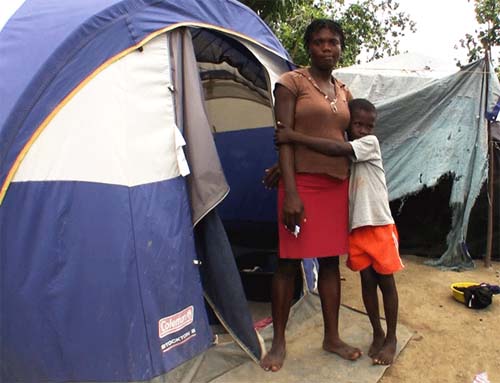Christmas Day brought the tragic news of the loss of a ship along the coast of Cuba carrying 124 migrants from Haiti seeking a better life. Thirty-seven people perished, 87 were rescued by Cuba’s coast guard. What has happened to the promised reconstruction of Haiti, two years following the earthquake of January 12, 2010? Why are Haitians taking desperate measures to flee their homeland or expressing their impatience or loss of hope in other forms?
Part of the answer can be found in the economic course being charted by Haiti’s leaders as they follow the advice, nay, insistence, of the U.S., Canada and Europe that foreign investment in sweatshop factories will take the country forward. It’s the “model” for Haiti’s future, President Michel Martelly recently pronounced.
In a word, it’s the same old, same old, for Haiti. Factory investment is the failed panacea that the United States has been pushing on Haiti for decades and that international finance gurus such as Paul Collier trumpet. They have nothing to show for it.
In the past two months, Haiti has been awash in economic conferences that bring foreign investors to the county and sell them on the merits of Haiti’s cheap labour. Former U.S President Bill Clinton is a prime mover in all of this. He sells himself unabashedly in this role, as his opening remarks to the Nov. 29-30 Invest In Haiti Forum (link to video below) illustrate.
The forum was sponsored by the Government of Haiti, the Inter American Development Bank (IADB) and the Clinton Foundation. It drew more than 1,000 investors and government officials from 29 countries. Here is a glowing report on the meeting published on the IADB website. You can watch here the 22-minute speech delivered by Clinton at the opening of the Forum.
He delivers a strong endorsement of the government of President Martelly, saying it is the “first Haitian government” he has known that is seriously concerned about the economy of the country.
President Martelly told journalists at the Forum that he is embarked on a strategy to create “half a million” jobs in the next three years. He did not explain how and where these jobs would be created.
Three investments were announced at the Forum — two hotels to be constructed in Port au Prince, including one by Marriott International in partnership with Digicel, and an electric cable factory to be built by the South Korean LG Group.
The Forum opened one day after a ceremony marking the beginning of construction of the Caracol Industrial Park, located on prime farmland in the north of Haiti (read a report here). It is claimed that this project by South Korean investors will eventually result in 20,000 factory jobs.
An article in the December 7 Haiti Liberté weekly newspaper provided some background to the Invest In Haiti Forum, the second such forum to take place. At the first Invest In Haiti Forum in 2009, President Clinton spoke of several billion dollars of investment that would be coming to Haiti. None of that ever materialized.
Haiti Liberté reports that during the period 2004-2006, following the coup d’etat against the elected government of president Jean Bertrand Aristide, more than 10,000 workers in public enterprises lost their jobs due to privatizations or restructurings. Among the enterprises where jobs were lost were the state telephone company (TELECO), the port authority (APN), the waste disposal company in Port au Prince (SMCRS), the water supply authority (CAMEP), the old-age insurance service (ONA) and the vehicle insurance authority (OAVCT).
The newly formed SOTA union reports that the number of assembly factories in Haiti has declined from 100 in 1986 to 23 today. Two key reasons for the decline are the absence of reliable electricity and political instability (both caused by incessant and destructive foreign political and military intervention).
SOTA reports that several thousand workers have been laid off from factories in Haiti over the past several months. Three of its members were recently fired for union organizing activity in the factory zone in Port au Prince and another three union members were fired in the north of the country. (Latest reports indicate that an international campaign of pressure forced the companies to rehire those workers.)
A comprehensive study by Haiti Grassroots Watch on the past, present and future of labour-intensive factory investment in Haiti has just been published. The study challenges the claim that such investment can serve as a driving force for Haiti to advance economically.
Among other findings, the study reveals that the daily minimum wage of factory workers today in Haiti, adjusted for inflation, is one half what it was in 1982. An average factory worker earns US$5.90 per day. He or she spends about half of that on their daily lunch and on transportation to and from work.
The study raises serious questions about the environmental and social impact of locating the Caracol Industrial Park in the countryside and on prime agricultural land.
The website of the Canada Haiti Action Network is a comprehensive source of news and information on Haiti. Roger Annis is one of its editors.



